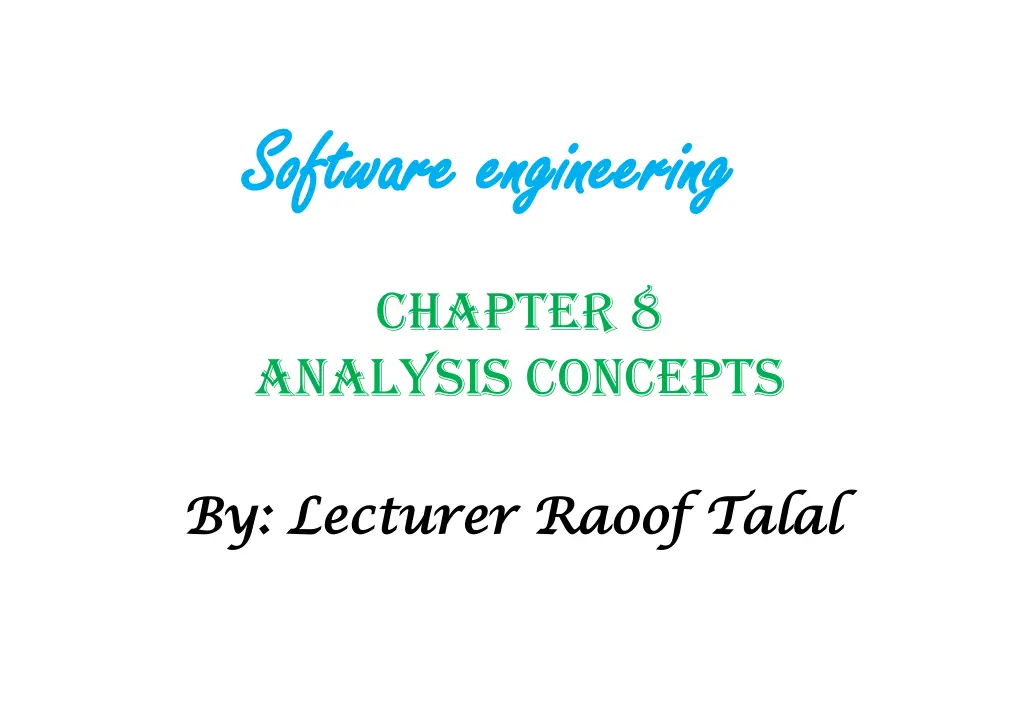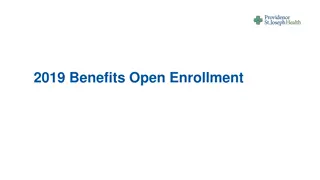
Understanding Data Objects and Attributes in Software Engineering
Explore the concepts of data objects and attributes in software engineering, including the representation of composite information, defining data objects, attributes, and identifiers, and determining appropriate attribute sets. Learn how to represent data objects in tables and understand their significance in software development.
Download Presentation

Please find below an Image/Link to download the presentation.
The content on the website is provided AS IS for your information and personal use only. It may not be sold, licensed, or shared on other websites without obtaining consent from the author. If you encounter any issues during the download, it is possible that the publisher has removed the file from their server.
You are allowed to download the files provided on this website for personal or commercial use, subject to the condition that they are used lawfully. All files are the property of their respective owners.
The content on the website is provided AS IS for your information and personal use only. It may not be sold, licensed, or shared on other websites without obtaining consent from the author.
E N D
Presentation Transcript
Software engineering Software engineering Chapter 8 Analysis concepts By: By: Lecturer Lecturer Raoof Raoof Talal Talal
Data objects: A data object is a representation of almost any composite information that must be understood by software. By composite information, we mean something that has a number of different properties or attributes. Therefore, width (a single value) would not be a valid data object, but dimensions (incorporating height, width, and depth) could be defined as an object.
Adata object can be : an external entity (e.g., anything that produces or consumes information) a thing (e.g.: a report) event (e.g.: an alarm) a role (e.g., salesperson) a place (e.g., a warehouse) or a structure (e.g., a file). For example, a person or a car (Figure 8.2) can be viewed as a data object that can be defined in terms of a set of attributes. The data object description incorporates the data object and all of its attributes.
The data object can be represented as a table as shown in Figure 8.3. The headings in the table reflect attributes of the object. In this case, a car is defined in terms of make, model, ID number, body type, color and owner. The body of the table represents specific instances of the data object. For example, a BMW 750iL is an instance of the data object car.
Attributes: Attributes define the properties of a data object. one or more of the attributes must be defined as an identifier that is, the identifier attribute becomes a "key" when we want to find an instance of the data object. In some cases, values for the identifier(s) are unique, although this is not a requirement. Referring to the data object car, a reasonable identifier might be the ID number.
The set of attributes that is appropriate for a given data object is determined through an understanding of the problem. The attributes for car might serve well for an application that would be used by a Department of Motor Vehicles, but these attributes would be useless for an automobile company that needs manufacturing control software.
In the latter case, the attributes for car might also include ID number, body type and color, but many additional attributes (e.g., interior code, drive train type, trim package designator, transmission type) would have to be added to make car a meaningful object in the manufacturing control context.
Relationships: Data objects are connected to one another in different ways. Data objects are related to one another. For example, person can own car, where the relationship own connotes a specific "connection between person and car. Consider two data objects, book and bookstore. These objects can be represented using the simple notation illustrated in Figure 8.4a. A connection is established between book and bookstore because the two objects are related. But what are the relationships?
To determine the answer, we must understand the role of books and bookstores within the context of the software to be built. We can define a set of object/relationship pairs that define the relevant relationships. For example, Abookstore orders books. Abookstore displays books. Abookstore stocks books. Abookstore sells books. Abookstore returns books.
The relationships orders, displays, stocks, sells, and returns define the relevant connections between book and bookstore. Figure 8.4b illustrates these object/relationship pairs graphically. It is important to note that object/relationship pairs are bidirectional. That is, they can be read in either direction. A bookstore orders books or books are ordered by a bookstore.
Taking into consideration all combinations of 'one' and 'many , two objects can be related as: One-to-one (l:l) An occurrence of object 'A' can relate to only one occurrence of object 'B' and an occurrence of 'B' can relate to only one occurrence of 'A'. One-to-many (l:N) One occurrence of object 'A' can relate to one or many occurrences of object 'B', but an occurrence of 'B' can relate to only one occurrence of 'A'
For example, a mother can have many children, but a child can have only one mother. Many-to-many (M:N) An occurrence of object 'A' can relate to one or more occurrences of 'B', while an occurrence of 'B' can relate to one or more occurrences of 'A'. For example, an uncle can have many nephews, while a nephew can have many uncles.
8.6.2 Entity/Relationship Diagrams The ERD was originally proposed for the design of relational database systems and has been extended later. A set of primary components are identified for the ERD: data objects, attributes, relationships, and various type indicators. The primary purpose of the ERD is to represent data objects and their relationships.
Data objects are represented by a labeled rectangle. Relationships are indicated with a labeled line connecting objects. In some variations of the ERD, the connecting line contains a diamond that is labeled with the relationship.
The relationship between the data objects car and manufacturer would be represented as shown in Figure 8.6. One manufacturer builds one or many cars. Given the context implied by the ERD, the specification of the data object car (data object table in Figure 8.5) would be radically different from the earlier specification (Figure 8.3) .
In addition to the basic ERD notation introduced in Figures 8.5, the analyst can represent data object type hierarchies. In many instances, a data object may actually represent a class or category of information. For example, the data object car can be categorized as domestic, European, or Asian. The ERD notation shown in Figure 8.6 represents this categorization in the form of a hierarchy.
ERD notation also provides a mechanism that represents the associativity between objects. An associative data object is represented as shown in Figure 8.7. In the figure, each of the data objects that model the individual subsystems is associated with the data object car.
8.7 Functional Modeling and Information Flow Information is transformed as it flows through a computer- based system. The system accepts input in a variety of forms; applies hardware, software, and human elements to transform it; and produces output in a variety of forms. Input may be a control signal, a series of numbers typed by a human operator, or a data file retrieved from secondary storage.
The transform(s) may comprise a single logical comparison, A complex numerical algorithm, or a rule- inference approach of an expert system. Output may light a single LED or produce a multi-page report. In effect, we can create a flow model for any computer-based system, regardless of size and complexity.
A computer- based system is represented as information transform as shown in Figure 8.8. A rectangle is used to represent an external entity; that is, a system element (e.g., hardware, a person, or program) or another system that produces or receives information. A circle (sometimes called a bubble) represents a process or transform that is applied to data (or control) and changes it in some way. An arrow represents one or more data items (data objects)
All arrows on a data flow diagram should be labeled. The double line represents a data store stored information that is used by the software.
8.7.1 Data Flow Diagrams As information moves through software, it is modified by a series of transformations. A data flow diagram is a graphical representation that depicts information flow and the transforms that are applied as data move from input to output. The basic form of a data flow diagram, also known as a data flow graph or a bubble chart, is illustrated in Figure 8.8.
A level 0 DFD, also called a fundamental system model or a context model, represents the entire software element as a single bubble with input and output data indicated by incoming and outgoing arrows, respectively. Additional processes (bubbles) and information flow paths are represented as the level 0 DFD is partitioned to reveal more detail. For example, a level 1 DFD might contain five or six bubbles with interconnecting arrows. Each of the processes
represented at level 1 is a sub function of the overall system depicted in the context model. As we noted earlier, each of the bubbles may be refined or layered to depict more detail. Figure 8.9 illustrates this concept. A fundamental model for system F indicates the primary input is A and ultimate output is B. We refine the F model into transforms f1 to f7. Note that information flow continuity must be maintained; that is, input and output to
each refinement must remain the same. This concept, sometimes called balancing, is essential for the development of consistent models. Further refinement of f4 depicts detail in the form of transforms f41 to f45. Again, the input (X, Y) and output (Z) remain unchanged.
8.7.2 Control Flow Diagrams In conventional data flow diagrams, control or event flows are not represented explicitly. In fact, the software engineer is cautioned to specifically exclude the representation of control flow from the data flow diagram. This exclusion is overly restrictive when real-time applications are considered, and for this reason, a specialized notation for representing event flows and control processing has been developed.
Continuing the data flow diagrams, data flow is represented using a solid arrow. Control flow, is represented using a dashed or shaded arrow. A process that handles only control flows, called a control process, is similarly represented using a dashed bubble.
Control flow can be input directly to a conventional process or into a control process. Figure 8.10 illustrates control flow and processing. The figure illustrates a top- level view of a data and control flow for a manufacturing cell.






















